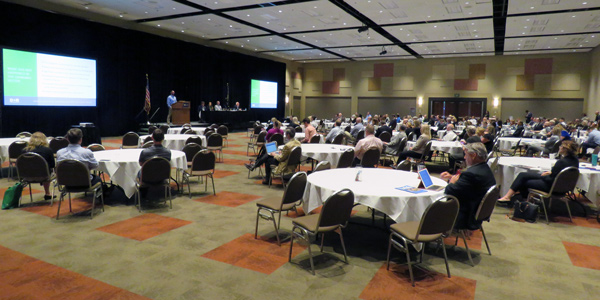By Jason Fordney
BOISE, Idaho — With the prospects for large nuclear plants becoming increasingly difficult in the U.S., nuclear proponents last week expressed excitement about the future of small modular reactors, touting their flexibility and lower capital cost.
Small modular units offer the clean benefits of nuclear while being more easily tailored to varying usage and sites, and the technology is seeing significant federal investment and partnership, industry experts told the annual meeting of Western Conference of Public Service Commissioners. During a panel discussion, they noted that other countries such as China and Russia are pursuing nuclear while it is being driven out of markets in the U.S.
Moderator Stan Wise, former chairman of the Georgia Public Service Commission, noted that the panel didn’t include any opposing viewpoints as is often the case at similar events. He said the discussion was “informational” and not about whether nuclear should — or should not — be pursued.
Wise stepped down as chairman of the state commission in February, maintaining his support for the continuing expansion of the controversial Vogtle nuclear plant — a stance for which he was “unapologetic,” he told the audience. (See Georgia PSC Votes to Complete Vogtle Units.)
“I think we need to be aware of opportunities for changes, for enhancements and for a new paradigm,” Wise said.
The current nuclear fleet is a “24/7” baseload resource that provides about 60% of non-greenhouse gas-emitting generation in the U.S., said Doug Little, who left the Arizona Corporation Commission last year to join the Department of Energy as deputy assistant secretary for intergovernmental and external affairs. Portions of Little’s comments echoed the Trump administration’s conclusion that nuclear units, along with coal plants, contribute to national security, the subject of a controversial order issued by the president last week. (See More Questions than Answers for FERC, RTOs on Bailout.)
“The department has been very supportive of this technology,” Little said. “We don’t want to see the industry move offshore in terms of the technology and the knowledge base.” He pointed to the benefits of small nuclear because of its modular nature and flexibility in siting.
Little used the analogy of a Ford F-150 pickup truck and a Prius hybrid electric vehicle. While the large utility vehicle might have a high operating cost and be less environmentally efficient than a compact EV, “I can do things with that F-150 that I can’t do with a Prius,” such as hauling a large load of hay on a farm. There are national security benefits of baseload plants, he argued, as 98% of military facilities get power from utilities and gas supply disruptions and price spikes can occur.
“How do we properly value these assets?” Instead of focusing strictly on price, the reliability value of nuclear should be considered, Little said. “I think the conversation needs to be broadened a bit, and that is what we’re trying to do at the department.”
Economic factors have shut down six reactors in the U.S. since 2013, with 12 more planned to go offline by 2025, said Rita Baranwal, director of the Idaho National Laboratory’s Gateway for Accelerated Innovation in Nuclear (GAIN) program. There are only two reactors under construction in the U.S., but there are 18 being built in China with another 31 planned, and five under construction in Russia with 22 more planned, she noted in a presentation. There are currently 440 operating reactors in 30 countries and 50 under construction in 13 countries around the world, she said.
“We want to ensure we have the continuing operation of the existing [U.S.] fleet,” Baranwal said.
Jose Reyes, chief technology officer of Oregon-based NuScale Power, described the giddy growth arc of the company founded in 2007. The Nuclear Regulatory Commission accepted the design application for its small modular reactor for review in March 2017, seen as a breakthrough regulatory hurdle for the technology. About $720 million has been invested in the technology, including $226 million from DOE in a competitive funding opportunity and a $40 million DOE matching fund award this month.
The NuScale Power Module can be stacked in up to 12 units for 600 MW in gross output. Its first deployment, a 12-module plant at a Utah Associated Municipal Power Systems site, is due for 2026 commercial operation.
“It’s exciting for me to see how this small dream has gotten this far,” Reyes said. “I wake up in the mornings and I pinch myself.”






